| Chemical structure | Common name | Chemical name | CAS number |
|---|
 | 2-Fluoroacrylfentanyl | N-(2-Fluorophenyl)-N-[1-(2-phenylethyl)-4-piperidinyl]-propen-2-amide | 2309383-09-1 |
 | 2-Fluorobutyrfentanyl (o-FBF) | N-(2-Fluorophenyl)-N-[1-(2-phenylethyl)-4-piperidinyl]-butanamide | 2163847-76-3 |
 | 2-Fluoroisobutyrfentanyl (o-FIBF) | N-(2-Fluorophenyl)-N-[1-(2-phenylethyl)-4-piperidinyl]-2-methylpropanamide | 2351142-33-9 |
 | 2-Methylacetylfentanyl (o-MAF) | N-(2-Methylphenyl)-N-[1-(2-phenylethyl)-4-piperidinyl]-acetamide | 90736-11-1 |
 | 2-Methylmethoxyacetylfentanyl | N-(2-Methylphenyl)-N-[1-(2-phenylethyl)-4-piperidinyl]-2-methoxyacetamide | |
 | 2,5-Dimethylfentanyl | N-[2,5-Dimethyl-1-(2-phenylethyl)piperidin-4-yl]-N-phenylpropanamide | 42045-97-6 |
 | 2,2'-Difluorofentanyl | N-(2-Fluorophenyl)-N-[1-(2-[2-fluorophenyl]ethyl)-4-piperidinyl]-propanamide | 2748343-87-3 |
 | 3-Allylfentanyl | N-[(3S,4R)-1-Phenethyl-3-prop-2-enylpiperidin-4-yl]-N-phenylpropanamide | 82208-84-2 |
 | 3-Fluorofentanyl (NFEPP) | N-(3-Fluoro-1-phenethylpiperidin-4-yl)-N-phenylpropionamide | 1422952-84-8 |
 | 3-Furanylfentanyl (3FUF) | N-Phenyl-N-[1-(2-phenylethyl)piperidin-4-yl]furan-3-carboxamide | 101343-82-2 |
 | 3-Methylbutyrfentanyl | N-[3-Methyl-1-(2-phenylethyl)piperidin-4-yl]-N-phenylbutanamide | 97605-09-9 |
 | 3-Methylcrotonylfentanyl | N-Phenyl-N-[1-(2-phenylethyl)-4-(3-methylpiperidin-1-yl)]-2-butenamide | |
 | p-Methylcrotonylfentanyl | N-(4-methylphenyl)-N-[1-(2-phenylethyl)-4-(piperidin-1-yl)]-2-butenamide | |
 | 3-Methylfentanyl (3-MF) | N-(3-methyl-1-phenethyl-4-piperidyl)-N-phenyl-propanamide | 42045-86-3 |
 | 3-Methylfuranylfentanyl [23] (3MFUF, TMFUF) | N-Phenyl-N-[3-methyl-1-(2-phenylethyl)piperidin-4-yl]furan-2-carboxamide | |
 | 3-Methylthiofentanyl | N-{3-Methyl-1-[2-(2-thienyl)ethyl]piperidin-4-yl}-N-phenylpropanamide | 86052-04-2 |
 | 3-Phenylpropanoylfentanyl [24] | N-Phenyl-N-[1-(2-phenylethyl)piperidin-4-yl]-3-phenylpropanamide | 79279-02-0 |
 | 4-Fluorobutyrfentanyl (4-FBF) | N-(4-Fluorophenyl)-N-[1-(2-phenylethyl)-4-piperidinyl]-butanamide | 244195-31-1 |
 | 4-Chloroisobutyrylfentanyl (4-CIBF) [25] | 2-Methyl-N-(4-chlorophenyl)-N-[1-(1-phenylpropan-2-yl)piperidin-4-yl]propanamide | 244195-34-4 |
 | 4-Fluoroisobutyrfentanyl (4-FIBF) | N-(4-Fluorophenyl)-N-[1-(2-phenylethyl)-4-piperidinyl]-isobutanamide | 244195-32-2 |
 | 4-Fluorofentanyl | N-(4-fluorophenyl)-N-[1-(2-phenylethyl)piperidin-4-yl]propanamide | 90736-23-5 |
 | Paramethylfentanyl (p-MF) | N-(4-methylphenyl)-N-[1-(2-phenylethyl)piperidin-4-yl]propanamide | 1838-67-1 |
 | para-fluorofuranylfentanyl [26] (p-F-Fu-F) | N-(1-phenethylpiperidin-4-yl)-N-(4-fluorophenyl)furan-2-carboxamide | 1802489-71-9 |
 | para-chlorofuranylfentanyl (p-Cl-Fu-F) | N-(1-phenethylpiperidin-4-yl)-N-(4-chlorophenyl)furan-2-carboxamide | |
 | ortho-methylfuranylfentanyl (o-Me-Fu-F) | N-(1-phenethylpiperidin-4-yl)-N-(o-tolyl)furan-2-carboxamide | 2309383-07-9 |
 | ortho-methoxyfuranylfentanyl (o-MeO-Fu-F) | N-(1-phenethylpiperidin-4-yl)-N-(2-methoxyphenyl)furan-2-carboxamide | 101343-50-4 |
 | ortho-isopropylfuranylfentanyl (o-iPr-Fu-F) | N-(1-phenethylpiperidin-4-yl)-N-(2-isopropylphenyl)furan-2-carboxamide | |
 | 4-Phenylfentanyl | N-Phenyl-N-[4-phenyl-1-(2-phenylethyl)piperidin-4-yl]propanamide | 120448-97-7 |
 | 4-Methoxybutyrfentanyl | N-(4-Methoxyphenyl)-N-[1-(2-phenylethyl)-4-piperidinyl]-butanamide | 2088842-68-4 |
 | para-Hydroxy‐butyrylfentanyl [27] | N-(4-hydroxyphenyl)-N-[1-(2-phenylethyl)-4-piperidinyl]-butanamide | |
 | 4"-Fluorofentanyl | N-[1-[2-(4-Fluorophenyl)ethyl]-4-piperidinyl]-N-phenylpropanamide | 2748343-99-7 |
 | 4"-Fluoro-o-fluoro-3-methylfentanyl | N-(2-fluorophenyl)-N-[1-[2-(4-fluorophenyl)ethyl]-3-methylpiperidin-4-yl]propanamide | |
 | 4-Methyl-methoxyacetylfentanyl (4-Me-MAF) | N-(4-Methylphenyl)-N-[1-(2-phenylethyl)-4-piperidinyl]-2-methoxyacetamide | |
 | 4-Methylphenethylacetylfentanyl [28] | N-[1-[2-(4-Methylphenyl)ethyl]-4-piperidinyl]-N-phenylacetamide | 1071703-95-1 |
 | Acrylfentanyl | N-Phenyl-N-[1-(2-phenylethyl)piperidin-4-yl]prop-2-enamide | 82003-75-6 |
 | α-Methylacetylfentanyl | N-Phenyl-N-[1-(1-phenylpropan-2-yl)-4-piperidyl]acetamide | 101860-00-8 |
 | α-Methylbutyrfentanyl | N-phenyl-N-[1-(1-phenylpropan-2-yl)-4-piperidyl]butanamide | 244195-36-6 |
 | α-Methylfentanyl (AMF) | N-phenyl-N-[1-(1-phenylpropan-2-yl)-4-piperidyl]propanamide | 79704-88-4 |
 | α-Methylthiofentanyl | N-Phenyl-N-[1-(1-thiophen-2-ylpropan-2-yl)-4-piperidyl]propanamide | 103963-66-2 |
 | α-Methyl-β-hydroxyfentanyl [29] | N-[1-(1-hydroxy-1-phenylpropan-2-yl)piperidin-4-yl]-N-phenylpropanamide | |
 | Acetylfentanyl | N-(1-Phenethylpiperidin-4-yl)-N-phenylacetamide | 3258-84-2 |
 | Alfentanyl | N-{1-[2-(4-ethyl-5-oxo-4,5-dihydro-1H-1,2,3,4-tetrazol-1-yl)ethyl]-4-(methoxymethyl)piperidin-4-yl}-N-phenylpropanamide | 71195-58-9 |
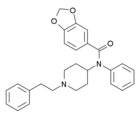 | Benzodioxolefentanyl [30] | N-Phenyl-N-[1-(2-phenylethyl)piperidin-4-yl]-2H-1,3-benzodioxole-5-carboxamide | 2306823-01-6 |
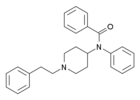 | Benzoylfentanyl | N-(1-Phenethylpiperidin-4-yl)-N-phenylbenzamide | 2309383-15-9 |
 | Benzylfentanyl | N-(1-Benzylpiperidin-4-yl)-N-phenylpropanamide | 1474-02-8 |
 | BDBM50223545 (Berger Fentanyl) [31] [32] | 1-[2-(2-phenylethyl)-3,4,4a,9b-tetrahydro-1H-pyrido[4,3-b]indol-5-yl]propan-1-one | |
 | β-Hydroxyfentanyl | N-[1-(2-Hydroxy-2-phenylethyl)piperidin-4-yl]-N-phenylpropanamide | 78995-10-5 |
 | β-Hydroxythiofentanyl | N-{1-[2-Hydroxy-2-(thiophen-2-yl)ethyl]piperidin-4-yl}-N-phenylpropanamide | 1474-34-6 |
 | β-Hydroxy-4-methylfentanyl | N-[1-(2-hydroxy-2-phenylethyl)-4-methylpiperidin-4-yl]-N-phenylpropanamide | |
 | β-Methylfentanyl | N-Phenyl-N-[1-(2-phenylpropyl)piperidin-4-yl]propanamide | 79146-56-8 |
 | Brorphine [33] | 1-{1-[1-(4-bromophenyl)ethyl]piperidin-4-yl}-1,3-dihydro-2H-benzimidazol-2-one | 2244737-98-0 |
 | Butyrfentanyl (Bu-F, BUF) | N-(1-(2-Phenylethyl)-4-piperidinyl)-N-phenylbutyramide | 1169-70-6 |
 | Brifentanyl | N-[(3R,4S)-1-[2-(4-Ethyl-5-oxotetrazol-1-yl)ethyl] -3-methylpiperidin-4-yl]-N-(2-fluorophenyl)-2-methoxyacetamide | 101345-71-5 |
 | Carfentanyl | Methyl 1-(2-phenylethyl)-4-[phenyl(propanoyl)amino]piperidine-4-carboxylate | 59708-52-0 |
 | Benzylcarfentanil | Methyl 1-benzyl-4-[phenyl(propanoyl)amino]piperidine-4-carboxylate | 61085-72-1 |
 | Ethylcarfentanil | Ethyl 1-(2-phenylethyl)-4-[phenyl(propanoyl)amino]piperidine-4-carboxylate | |
 | Crotonylfentanyl | N-Phenyl-N-[1-(2-phenylethyl)-4-piperidinyl]-2-butenamide | 760930-59-4 |
 | Cyclopentylfentanyl | N-phenyl-N-[1-(2-phenylethyl)piperidin-4-yl]cyclopentanecarboxamide | 2088918-01-6 |
 | Cyclobutylfentanyl [34] | N-[1-(2-Phenylethyl)piperidin-4-yl]-N-phenylcyclobutanecarboxamide | 2306827-55-2 |
 | Cyclopropylfentanyl | N-[1-(2-Phenylethyl)piperidin-4-yl]-N-phenylcyclopropanecarboxamide | 1169-68-2 |
 | EAZ-91-05, Psicofentanil | (quinuclidin-3-yl) 4-[phenyl(propanoyl)amino]-1-[2-(indol-3-yl)ethyl]piperidine-4-carboxylate | |
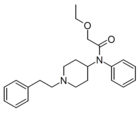 | Ethoxyacetylfentanyl | 2-ethoxy-N-(1-phenethylpiperidin-4-yl)-N-phenylacetamide | |
 | Isobutyrylfentanyl | 2-methyl-N-phenyl-N-[1-(1-phenylpropan-2-yl)piperidin-4-yl]propanamide | 119618-70-1 |
 | Isofentanyl | N-(1-Benzyl-3-methylpiperidin-4-yl)-N-phenylpropanamide | 79278-40-3 |
 | Homofentanyl (N-phenylpropylnorfentanyl) [35] | N-phenyl-N-[1-(3-phenylpropyl)piperidin-4-yl]propanamide | 59708-54-2 |
 | R-4173 [36] | N-phenyl-N-{1-[4-(4-fluorophenyl)-4-oxobutyl]piperidin-4-yl}propanamide | 2413-90-3 |
 | trans-phenylcyclopropyl-norfentanyl | 1-(trans-2-Phenylcyclopropyl)-4-(N-propionylanilino)piperidine. | 102504-49-4 |
 | Fentanyl azepane | N-phenyl-N-[1-(2-phenylethyl)azepan-4-yl]propanamide | |
 | Fentanyl carbamate | ethyl N-phenyl-N-[1-(2-phenylethyl)piperidin-4-yl]carbamate | 1465-20-9 |
 | Pyridylfentany [37] | N-phenyl-N-[1-(2-pyridin-4-ylethyl)piperidin-4-yl]propanamide | 1443-41-0 |
 | Furanylbenzylfentanyl | N-Phenyl-N-(1-benzylpiperidin-4-yl)furan-2-carboxamide | 497240-21-8 |
 | Furanylfentanyl (Fu-F, FUF) | N-Phenyl-N-[1-(2-phenylethyl)piperidin-4-yl]furan-2-carboxamide | 101345-66-8 |
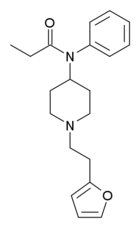 | Furanylethylfentanyl (FUEF) | N-[1-[2-(2-furanyl)ethyl]-4-piperidinyl]-N-phenyl-propanamide | 802544-02-1 |
 | 2-Benzofuranylethyl-alpha-methylfentanyl | N-(1-[1-(1-Benzofuran-2-yl)-2-propanyl]-4-piperidinyl)-N-phenylpropanamide | |
 | Fentanyl 4-methylene analogue (WO 2007/093603) | N-phenyl-N-{[1-(2-phenylethyl)piperidin-4-yl]methyl}propanamide | 947139-57-3 |
 | Indolylethylfentanyl | N-(1-[2-(1H-indol-3-yl)ethyl]-4-piperidinyl)-N-phenyl-propanamide | 58399-46-5 |
 | IQMF-4 [38] | N-[1-(2-Phenylethyl)piperidin-4-yl]-N-(1-phenylpyrazol-3-yl)prop-2-enamide | 497100-48-8 |
 | Lofentanyl | methyl (3S,4R)-3-methyl-1-(2-phenylethyl)-4-[phenyl(propionyl)amino]piperidine-4-carboxylate | 61380-40-3 |
 | N-Methylnorcarfentanyl | methyl 1-methyl-4-(N-phenylpropanamido)piperidine-4-carboxylate | 59708-50-8 |
 | Methoxyacetylfentanyl (MAF) | 2-Methoxy-N-(1-phenethylpiperidin-4-yl)-N-phenylacetamide | 101345-67-9 |
 | meta-fluorofentanyl | N-(3-Fluorophenyl)-N-[1-(2-phenylethyl)-4-piperidinyl]-propanamide | 90736-22-4 |
 | Meta-fluoro-methoxyacetylfentanyl | 2-Methoxy-N-(1-phenethylpiperidin-4-yl)-N-(3-fluorophenyl)acetamide | 2306825-32-9 |
 | 4-(Methylthiazolyl)-pyrazolylethylfentanyl [39] | 1-[2-(1H-pyrazol-1-yl)ethyl]-4-(4-methylthiazol-2-yl)-4-(N-phenylpropionamido)piperidine | 120070-51-1 |
 | Mirfentanyl | N-[1-(2-Phenylethyl)piperidin-4-yl]-N-pyrazin-2-yl-2-furamide | 117523-47-4 |
 | MP102 | N-cycloheptyl-1-(2-phenylethyl)-4-(N-propanoylanilino)piperidine-4-carboxamide | |
 | MP135 [40] | N-[4-{[2-(3-fluorophenyl)ethyl]carboxamido}-1-(2-phenylethyl)piperidin-4-yl]-N-benzylpropanamide | 2677687-49-7 |
 | N-(MDA)-fentanyl [41] | N-(1-(1-(benzo[d][1,3]dioxol-5-yl)propan-2-yl)piperidin-4-yl)-N-phenylpropionamide | |
 | N-(2C-B)-fentanyl | N-(1-(2-(2,5-dimethoxy-4-bromophenyl)ethyl)piperidin-4-yl)-N-phenylpropionamide | |
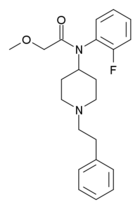 | Ocfentanyl | N-(2-Fluorophenyl)-2-methoxy-N-[1-(2-phenylethyl)piperidin-4-yl]acetamide | 101343-69-5 |
 | Ohmefentanyl | N-[1-(2-hydroxy-2-phenylethyl)-3-methylpiperidin-4-yl]-N-phenylpropanamide | 78995-14-9 |
 | Ohmecarfentanil | methyl 1-(2-hydroxy-2-phenylethyl)-3-methyl-4-(N-propanoylanilino)piperidine-4-carboxylate | |
 | 4"-Fluoroohmefentanyl | methyl 1-[2-hydroxy-2-(4-fluorophenyl)ethyl]-3-methyl-4-(N-propanoylanilino)piperidine-4-carboxylate | |
 | Orthofluorofentanyl | N-(2-Fluorophenyl)-N-[1-(2-phenylethyl)-4-piperidinyl]-propanamide | 910616-29-4 |
 | p-Bromofentanyl | N-(4-bromophenyl)-N-[1-(2-phenylethyl)-4-piperidinyl]-propanamide | 117994-23-7 |
 | p-Nitrofentanyl [42] | N-(4-Nitrophenyl)-N-[1-(2-phenylethyl)-4-piperidinyl]-propanamide | |
 | Parafluoroisobutyrylbenzylfentanyl | N-[(1-benzylpiperidin-4-yl)methyl]-N-(4-fluorophenyl)-2-methylpropanamide | |
 | 4-Fluorocyclopropylbenzylfentanyl | N-(1-benzylpiperidin-4-yl)-N-(4-fluorophenyl)cyclopropanecarboxamide | 2344231-47-4 |
 | Pivaloylfentanyl | 2,2-dimethyl-N-phenyl-N-[1-(2-phenylethyl)piperidin-4-yl]propanamide | |
 | Pyrrole-fentanyl [43] | N-[1-(2-Phenylethyl)piperidin-4-yl]-N-pyrrol-1-ylpropanamide | |
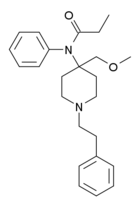 | R-30490 | N-[4-(Methoxymethyl)-1-(2-phenylethyl)piperidin-4-yl]-N-phenylpropanamide | 60618-49-7 |
 | Remifentanyl | methyl 1-(3-methoxy-3-oxopropyl)-4-(N-phenylpropanamido)piperidine-4-carboxylate | 132875-61-7 |
 | Remifentanil bis ethyl ester | ethyl 1-(3-ethoxy-3-oxopropyl)-4-(N-phenylpropanamido)piperidine-4-carboxylate | |
 | RR49 [44] | N-{1-[2-Fluoro-2-(2-fluorophenyl)ethyl]piperidin-4-yl}-N-phenylpropanamide | 2376328-79-7 |
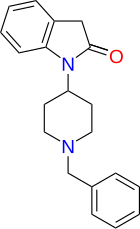 | SR-16412 [45] | 1-(1-benzylpiperidin-4-yl)-3H-indol-2-one | 16223-24-8 |
 | Secofentanyl [46] | N-phenyl-N-{4-[methyl(2-phenylethyl)amino]butan-2-yl}propanamide | 253342-66-4 |
 | Senecioylfentanyl [47] | N-phenyl-N-[1-(2-phenylethyl)-4-piperidinyl]-3-methylbut-2-enamide | 2630378-28-6 |
 | Sufentanil | N-[4-(Methoxymethyl)-1-(2-thiofuran-2-ylethyl)-4-piperidyl]-N-phenylpropanamide | 56030-54-7 |
 | Tetrahydrofuranylfentanyl | N-Phenyl-N-[1-(2-phenylethyl)piperidin-4-yl]oxolane-2-carboxamide | 2142571-01-3 |
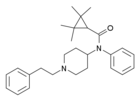 | Tetramethylcyclopropylfentanyl [48] | 2,2,3,3-Tetramethyl-N-(1-phenethylpiperidin-4-yl)-N-phenylcyclopropane-1-carboxamide | 2309383-11-5 |
 | Tetramethylfentanyl | N-(2,2,6,6-tetramethyl-1-phenethyl-4-piperidyl)-N-phenyl-propanamide | |
 | Thenylfentanyl | N-phenyl-N-{[1-(thiophen-2-ylmethyl)piperidin-4-yl]methyl}propanamide | 117332-93-1 |
 | Thiafentanil | methyl 4-(N-(2-methoxyacetyl)anilino)-1-(2-thiophen-2-ylethyl)piperidine-4-carboxylate | 101345-60-2 |
 | Thiofentanyl | N-phenyl-N-{1-[2-(2-thienyl)ethyl]piperidin-4-yl}propanamide | 1165-22-6 |
 | Thiophenylfentanyl (Thiofuranylfentanyl) [49] | N-Phenyl-N-[1-(2-phenylethyl)piperidin-4-yl]thiophene-2-carboxamide | 2306823-38-9 |
 | Trefentanyl | N-{1-[2-(4-ethyl-5-oxo-4,5-dihydro-1H-tetrazol-1-yl)ethyl]-4-phenylpiperidin-4-yl}-N-(2-fluorophenyl)propanamide | 120656-93-1 |
 | Trifluorofentanyl [50] | N-(3,4-difluorophenyl)-N-[1-(2-[4-fluorophenyl]ethyl)-4-piperidinyl]-propanamide | |
 | Tropafentanyl (Fentanyl tropane) | N-phenyl-N-[8-(2-phenylethyl)-8-azabicyclo[3.2.1]octan-3-yl]propanamide | |
 | 3,4-dichloro-4''-methoxyfentanyl | N-(3,4-dichlorophenyl)-N-[1-(2-[4-methoxyphenyl]ethyl)-4-piperidinyl]-propanamide | 1161705-29-8 |
 | Ureafentanyl | N,N-dimethyl-N'-phenyl-N'-[1-(2-phenylethyl)-4-piperidinyl]-urea | 1443-50-1 |
 | Valerylfentanyl (VF) | N-(1-(2-Phenylethyl)-4-piperidinyl)-N-phenylpentylamide | 122882-90-0 |


















































































































































